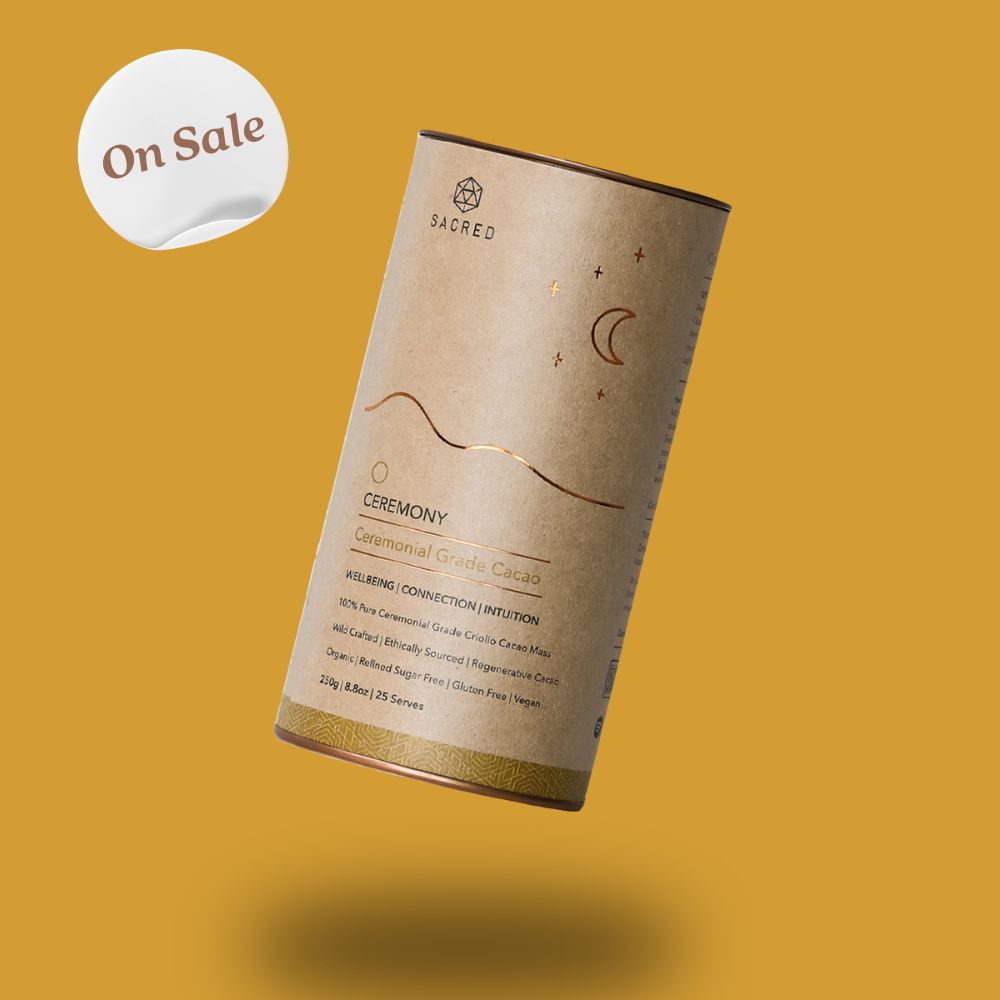There’s something deeply grounding about holding a warm cup of cacao on a cool Melbourne morning. I remember sitting in my backyard one autumn, the leaves crisping underfoot, when I first swapped my coffee for cacao. The shift wasn’t just in taste—it was in how I felt afterwards: steady, energised but not jittery, and with a curious lightness in my chest.
For centuries, cacao has been more than just food; it’s been medicine, ritual, and sustenance. The Mayans called it the “drink of the gods,” and modern science is slowly catching up to what traditional cultures have always known—this humble bean is brimming with compounds that nurture both body and spirit.
Why Cacao Stands Out As A Superfood?
When people talk about “superfoods,” the term often gets thrown around loosely. But cacao truly earns its place. Unlike its more processed cousin, cocoa, raw cacao retains a remarkable depth of nutrients. The difference is simple: cacao is fermented and dried at low temperatures, while cocoa is roasted at high heat, which strips away much of its vitality.
From my experience in ceremony and daily practice, cacao feels alive. It’s nutrient-rich in ways you can feel—supporting heart, brain, mood, and even the skin. If you’ve ever wondered why it’s more than just an indulgence, here’s the breakdown.
Cacao Vs Cocoa – What’s The Difference?
It’s worth getting our terms straight.
- Cacao: The raw, less-processed form. Fermented, dried, sometimes cold-pressed. Retains flavonoids, minerals, and antioxidants.
- Cocoa: Roasted at high heat, often blended with sugar or milk powders. Easier on the palate but lower in active compounds.
A simple way to picture it: cacao is like fresh-squeezed juice, full of vitality, while cocoa is more like cordial—still tasty, but not the same nutritional punch.
I’ve seen people surprised when they switch. They expect a “chocolate hit,” but what they feel is smoother energy and less crash. That difference often comes back to the preservation of minerals and polyphenols.
Key Nutrients Packed In Cacao
Cacao is one of the richest natural sources of magnesium—a mineral many Australians don’t get enough of, especially in winter when diets tend to lean heavily on processed comfort foods. Magnesium supports muscle function, helps regulate blood pressure, and plays a role in calming the nervous system. I’ve shared cacao in community circles where people remark on how much more relaxed their body feels afterwards—often, that’s magnesium doing its quiet work.
But magnesium is only the beginning. Here’s a snapshot of what’s inside every spoonful of cacao:
|
Nutrient (per 100g raw cacao) |
Benefit for the body |
Comparison |
|
Magnesium (499mg) |
Nerve & muscle function, stress relief |
One of the highest plant-based sources |
|
Iron (13.9mg) |
Oxygen transport, energy |
More than spinach per 100g |
|
Potassium (1524mg) |
Circulation, fluid balance |
Almost double that of a banana |
|
Zinc (6.8mg) |
Immune function, skin repair |
Similar to pumpkin seeds |
|
Copper & Manganese |
Antioxidant enzyme support |
Found in trace but vital amounts |
When you see it laid out like this, it’s easy to understand why cacao isn’t just another ingredient—it’s a genuine superfood.

Cardiovascular Health Benefits Of Cacao
When I first began drinking cacao regularly, I didn’t expect to notice much beyond the taste. But one of the earliest changes I felt was in my circulation. My hands and feet—often cold during Melbourne’s winter—started to feel warmer after a daily cup. Later, I learned this wasn’t just in my head. Cacao flavonoids actively support blood flow, easing pressure on the heart and improving the way vessels expand and contract.
How Cacao Lowers Blood Pressure Naturally?
High blood pressure is a silent issue in Australia, affecting nearly one in three adults over 18. Many don’t even know they have it until a doctor points it out. Cacao offers a natural, supportive tool.
Flavanols in cacao stimulate nitric oxide production—a compound that relaxes artery walls, letting blood flow more freely. Think of it like oiling a rusty hinge; movement becomes smoother and less strained.
Research shows flavanol-rich cacao can lower systolic blood pressure by 2–5 mmHg. That might sound small, but even a few points make a difference in reducing long-term cardiovascular risks. In fact, some studies found that people with hypertension benefited the most.
Cacao And Heart Health – Cholesterol & Circulation
Cacao doesn’t just ease pressure; it also helps balance cholesterol. It can reduce LDL (bad cholesterol), increase HDL (good cholesterol), and protect LDL from oxidising. Oxidised LDL is sticky—it clings to artery walls, leading to plaque buildup. Preventing that process is key in slowing atherosclerosis.
Improved circulation is another gift. I often tell people: if your fingers feel warmer after cacao, that’s nitric oxide at work. Enhanced blood flow means your heart doesn’t have to pump as hard to deliver oxygen, and tissues receive nutrients more efficiently.
Reducing Risks Of Heart Attack And Stroke
The ripple effects are powerful. By lowering blood pressure, easing cholesterol issues, and improving circulation, cacao may lower the risk of serious cardiovascular events.
Here’s a quick look at what research has found:
- 27% lower risk of cardiovascular death in people supplementing with cocoa flavanols.
- 22% lower chance of stroke for those enjoying a weekly serving of dark chocolate.
- Improved arterial flexibility, particularly in older adults.
I think of it this way: cacao doesn’t just help you feel better in the moment; it’s quietly supporting long-term heart resilience.
Brain Health And Mood-Enhancing Effects
When I first sat in a cacao ceremony in Guatemala years ago, I was struck by more than the warmth in my chest. I felt lighter in spirit, clearer in thought, as though my mind had room to breathe. It wasn’t just the songs or the setting—it was the plant itself. Science now helps explain what traditional cultures knew: cacao is as much food for the brain as it is for the heart.
Cacao For Brain Health And Cognitive Function
The flavanols in cacao improve cerebral blood flow, meaning more oxygen and nutrients reach brain cells. This translates into sharper focus, better memory, and quicker processing.
Researchers have shown that older adults who drink flavanol-rich cocoa perform better in tasks involving executive function and working memory. In plain terms—less “fog,” more clarity.
I’ve seen this in everyday settings too. A friend of mine, a busy teacher in Melbourne’s northern suburbs, swapped her afternoon coffee for cacao. She found she could mark papers into the evening without that burnt-out crash. She described it as “steady clarity”—something coffee never gave her.
Mood-Enhancing Cacao And Neurotransmitters
Cacao contains compounds that quite literally change how we feel:
- Phenylethylamine (PEA): Known as the “love molecule,” it sparks endorphin release—like the natural high after a good run.
- Tryptophan: An amino acid used by the body to produce serotonin, our mood-regulating hormone.
- Anandamide: Nicknamed the “bliss molecule,” it interacts with dopamine receptors, encouraging feelings of contentment and ease.
I notice it most in ceremony. When people sip cacao slowly, they soften. Shoulders drop, and laughter flows more easily, sometimes with tears too. It’s the neurotransmitters at play—chemistry aligning with emotional release.
Even clinical studies back this up. One trial found that 85% dark chocolate reduced negative emotions in participants, proving that the effect isn’t just poetic—it’s measurable.
Stress Relief And Emotional Balance
We live in an age where stress feels like a constant companion. Cacao offers more than momentary comfort; it actually helps regulate the body’s stress response.
A 4-week study showed that high-polyphenol dark chocolate reduced cortisol levels—the hormone that spikes when we’re under pressure. Lower cortisol means less tension, steadier energy, and even improved sleep quality.
In my own circles, I’ve watched people arrive frazzled from Melbourne traffic and deadlines. After an hour with cacao, they sit taller, breathe slower, and often say, “I didn’t realise how much I needed that pause.”

Metabolism And Gut Health
Beyond the heart and brain, cacao plays a quiet but powerful role in how our body processes food and maintains balance. It supports blood sugar control, nurtures the gut microbiome, and even helps with managing a healthy weight. I’ve noticed that when I add cacao into my day, I snack less and feel more satisfied—it’s as though my body recognises it’s receiving something deeply nourishing.
Cacao Flavonoids And Diabetes Risk Reduction
Diabetes is on the rise in Australia, with almost 1.5 million people living with the condition. Diet plays a huge role in prevention and management. Studies show that flavanol-rich cacao improves insulin sensitivity and enhances the body’s ability to regulate glucose.
- A 2024 analysis found women eating five or more servings of dark chocolate a week had a 21% lower risk of type 2 diabetes.
- Flavanols boost nitric oxide production, which helps blood vessels deliver glucose to muscles more efficiently.
- Better circulation equals better energy use—less sugar “stuck” in the bloodstream.
For someone with a family history of diabetes, adding cacao to a balanced diet could be a simple, supportive habit.
Prebiotic Power – Supporting A Healthy Microbiome
What we feed our gut shapes our health. Cacao acts like a prebiotic—fuel for the beneficial bacteria in our intestines.
Once cacao flavanols reach the large intestine, gut microbes break them down into compounds that reduce inflammation and support digestion. A four-week study found that cacao boosted populations of Lactobacillus and Bifidobacterium (the “good guys”) while reducing harmful Clostridia.
I often encourage people in workshops to notice how they feel after a month of daily cacao compared to coffee or tea. Many report fewer bloating episodes and a calmer stomach. It’s subtle but consistent—the gut seems to welcome cacao.
Cacao For Weight Management Support
Cacao doesn’t work like a quick-fix diet pill—it’s subtler, but more sustainable. Here’s why it helps:
- Satiety: The fibre in raw cacao can increase fullness, making it easier to avoid over-snacking.
- Craving control: The magnesium helps curb sugar cravings—often, what people are truly missing is minerals, not more sugar.
- Metabolism boost: Flavanols may enhance fat oxidation, nudging the body to use energy more efficiently.
In practice, I’ve seen this with a participant in a Melbourne circle who swapped her nightly chocolate bar for a small cup of unsweetened cacao. Within weeks, she noticed she was reaching for less processed sugar and felt more in tune with her body’s hunger cues.
Antioxidant And Anti-Inflammatory Properties
One of the first things I learned while studying cacao in South America was just how revered it is as a plant of protection—not only spiritually, but physically. Long before science could measure flavonoids or ORAC values, traditional cultures knew cacao preserved vitality and slowed the visible signs of ageing. Today, research confirms that cacao is one of the richest antioxidant foods on the planet, with powerful anti-inflammatory effects to match.
Why Cacao Is Rich In Antioxidants?
Cacao contains polyphenols—plant compounds that scavenge free radicals before they can damage our cells. This oxidative stress, if unchecked, contributes to everything from wrinkles to chronic disease.
To put it in perspective, here’s how cacao stacks up against other celebrated antioxidant-rich foods:
|
Food (per 100g) |
Antioxidant Capacity (ORAC value) |
Notes |
|
Raw Cacao |
~55,000 |
Among the highest recorded in natural foods |
|
Blueberries |
~4,700 |
Popular “antioxidant fruit” |
|
Goji Berries |
~25,000 |
Considered a superfood, yet still below cacao |
|
Acai Powder |
~102,700 |
One of the few that rivals cacao |
Every time I share this table in workshops, people are floored. They’ve been adding blueberries to smoothies for years, but never realised that a spoonful of cacao powder carries more antioxidant strength than a whole handful of berries.
Fighting Inflammation With Flavanols
Inflammation is the body’s natural defence, but when it becomes chronic, it fuels diseases like arthritis, cardiovascular issues, and even some cancers. Cacao flavanols have been shown to lower inflammatory markers, creating a gentler internal environment.
I think of it like this: cacao doesn’t silence the body’s alarms, but it makes sure they’re not blaring all day long. Less background inflammation means the body can focus its energy where it’s truly needed—repair, renewal, and resilience.
Immune Boosting Cacao And Longevity
Cacao doesn’t stop at neutralising damage; it also strengthens our internal defences. The polyphenols and minerals like zinc and copper play key roles in immune function, helping white blood cells fight off infections.
There’s also the longevity factor. Communities with diets rich in cacao flavanols, such as the Kuna people of Panama, are known for remarkably low rates of heart disease and hypertension, even into old age. While diet is just one piece of their lifestyle, it’s hard to ignore how cacao contributes to their vitality and longevity.
I often tell people in ceremony: when you sip cacao, you’re not just enjoying a comforting drink—you’re investing in the body’s long game.
Skin, Energy, And Everyday Wellness
Cacao’s gifts reach right to the surface of our lives—literally on the skin, in the way we feel energised, and in those small daily rituals that keep us well. Over the years, I’ve noticed people first come to cacao for the taste, but they stay for how it weaves into their everyday wellbeing.
Cacao For Skin Health And Radiance
It always surprises people when I mention cacao as a skin food. The flavanols improve blood flow to the skin, boosting hydration, density, and elasticity. In one study, participants who consumed high-flavanol cacao daily for twelve weeks saw a noticeable reduction in roughness and increased protection against UV-induced redness.
In the ceremony, I’ve seen elders with glowing skin who attribute part of their vitality to their lifelong relationship with cacao. Here in Melbourne, I’ve shared it with people struggling through our harsh summers—they often remark their skin feels calmer and less irritated after a few weeks of regular use.
Natural Energy From Cacao
Many people turn to coffee for a jolt, but it often comes with the downside—jitters, a racing heart, or the dreaded crash. Cacao offers a different rhythm. Its main stimulant, theobromine, works more gently than caffeine, providing alertness without anxiety.
I like to call it “sustainable energy.” On days I’m running ceremonies back-to-back, a cup of cacao keeps me grounded and alert for hours. No sweaty palms, no sudden slump—just a steady current of energy.
Key points about cacao’s energy profile:
- Theobromine > caffeine: Gentler stimulant effect, longer lasting.
- Magnesium & iron: Support energy metabolism at the cellular level.
- Synergy with mood molecules: Creates alertness with ease, not tension.
Everyday Dark Chocolate Health Benefits
We don’t always need a full ceremonial brew to enjoy the benefits. Dark chocolate with a cacao content of at least 70% still carries flavanols and minerals.
Here’s a quick guide I share with friends wanting to bring cacao into their daily routine:
Checklist: Choosing Everyday Cacao Products
- Look for 70% or higher cacao content.
- Choose options with minimal added sugar.
- Favour raw, unprocessed forms when possible (powder, nibs, paste).
- Enjoy moderation: 20–40g a day is enough to feel benefits without overdoing stimulants.
Even something as simple as swapping an afternoon chocolate bar for a few squares of high-cacao dark chocolate can shift mood, boost energy, and contribute to long-term health.
How To Enjoy Cacao For Maximum Benefits?
The beauty of cacao is that it can slip seamlessly into daily life. Whether it’s a morning ritual, an afternoon reset, or part of a mindful ceremony, the way we prepare and consume it shapes the benefits we feel.
Best Ways To Consume Cacao Daily
There’s no single “right way” to enjoy cacao—it depends on what you’re looking for. In my own practice, I rotate between a ceremonial-style drink when I need depth and simple additions to meals for everyday nourishment.
Here are some tried-and-true methods:
- Warm cacao drink: Blend raw cacao with hot water and a touch of spice (like cinnamon or chilli) for a warming cup in winter.
- Smoothies: Add a tablespoon of cacao powder into your morning smoothie for energy and antioxidants.
- Sprinkle on breakfast: Scatter cacao nibs over porridge, yoghurt, or muesli for crunch and nutrition.
- Baking: Use cacao powder in muffins, bliss balls, or slices for a nutrient boost.
- Ceremonial cacao: Set aside quiet time, prepare with intention, and drink slowly—it’s as much about the mindset as the medicine.
One Melbourne mum I know adds cacao to her kids’ banana smoothies. She laughs that they think it’s a “treat,” when really it’s fuelling them with magnesium and antioxidants before school.
How Much Cacao Is Healthy Per Day?
Like all powerful plants, cacao is best enjoyed in balance. Too much can overstimulate, especially for those sensitive to theobromine or caffeine.
General guidelines (for healthy adults):
- Every day use: 20–40g raw cacao (powder, nibs, or paste).
- Ceremonial use: 40–50g, typically reserved for intentional practices.
- Dark chocolate: A few squares (20–30g) of 70% or higher cacao content.
Tips for safe use:
- Avoid late at night if you’re sensitive to stimulants.
- Stay hydrated—cacao’s mild diuretic effect can increase fluid loss.
- If pregnant, breastfeeding, or managing a heart condition, check with a health professional before regular use.
I often remind people in the circle: cacao is a teacher in moderation. It doesn’t need excess to do its work; even small amounts can bring steady energy, calm, and connection.
From heart health to brain clarity, radiant skin to calmer moods, cacao proves itself time and again as more than a comfort food. It’s a nutrient-dense plant with a lineage of healing that stretches back thousands of years. Whether shared in ceremony, sipped on a quiet Melbourne morning, or sprinkled into daily meals, cacao invites us to nourish body and spirit in one simple act.
As I’ve seen in my own life and in community circles, cacao is not about quick fixes or miracle claims—it’s about steady, sustainable wellness. When enjoyed with respect and balance, it becomes both food and ally, offering resilience for the long haul.
With love xx
Sacred Team
















